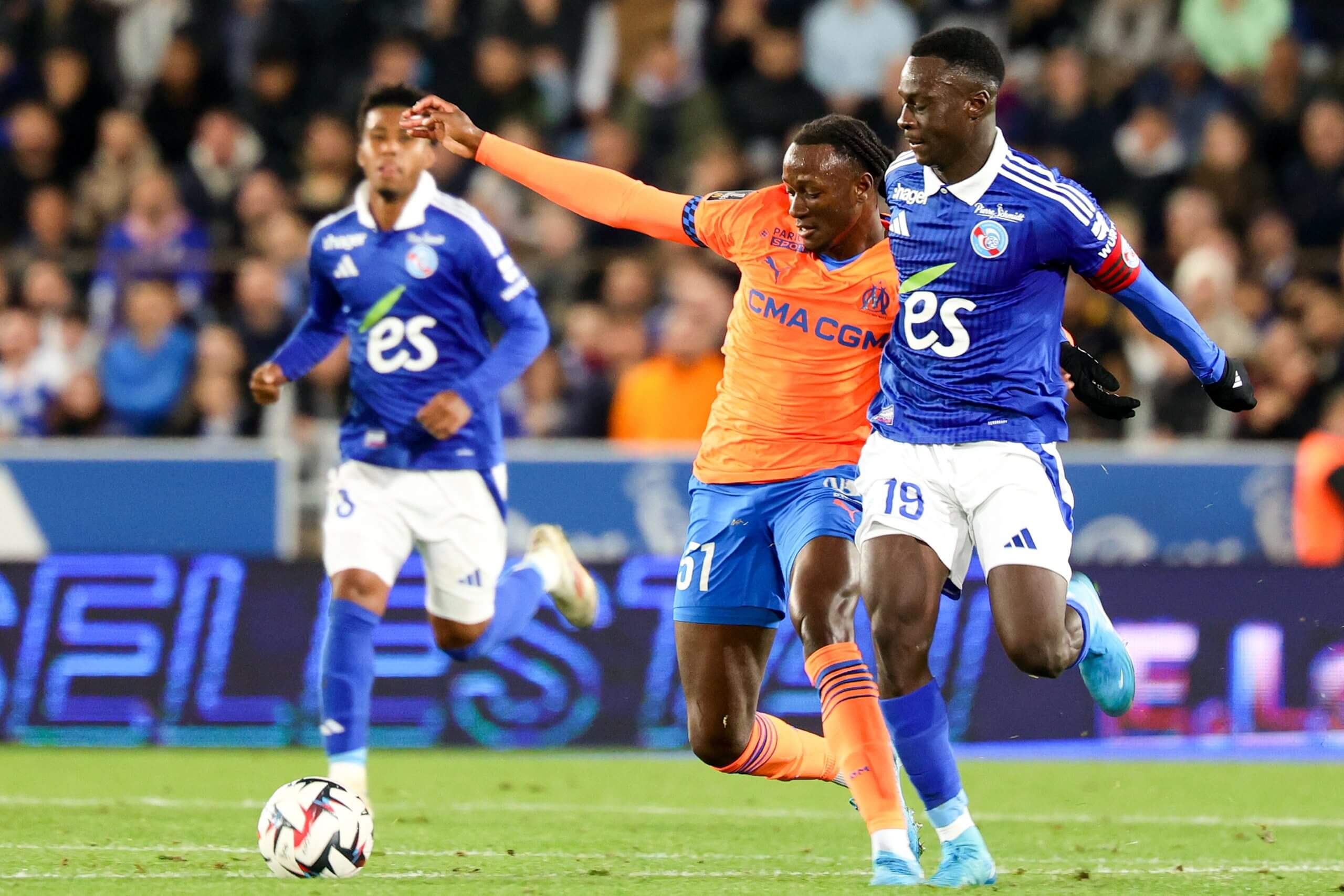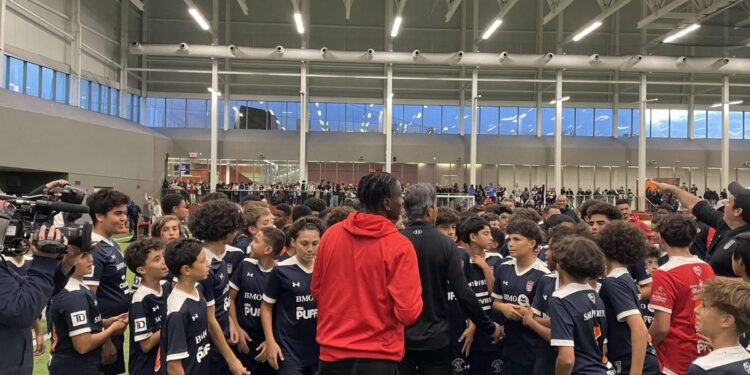Moise Bombito, back row fifth from left, Santiago Lopez, sixth from left, Stephen Eustaquio, fourth from right with children from CS Saint-Laurent (Club de Soccer de Saint-Laurent)
So why is this happening?
We can start with the area itself. Walking the streets of Montreal, the biggest city in the province of Quebec, it is clear how different it is to Toronto and Vancouver. The traditional European influence can be felt in MontrealŌĆÖs architecture and cuisine in a way that does not exist in most other major Canadian metropolises.
ŌĆ£The culture in Quebec is such that we like to develop creative players, we like players to express themselves, but I think weŌĆÖre also strong at putting this creativity under a structure,ŌĆØ Valerio Gazzola, Quebec SoccerŌĆÖs director of development, says.
ŌĆ£The multiculturalism of Montreal provides a breeding ground for the possibility of what we can develop out of that community,ŌĆØ Canada coach Jesse Marsch told reporters over Zoom when the camp was announced.
Technical skills are prioritized and multiple Montreal-based coaches spoke to The Athletic about ŌĆ£streetballŌĆØ, a term they use to describe how Montreal-based players learn the game.
ŌĆ£We like to play more of a Spanish version of the game, where we keep possession. We want to develop creative players in the final third. A lot of teams in Quebec want players to express themselves,ŌĆØ Nasson Theosmy, sporting director at Club de Soccer St-Hubert, said.
CS St-Hubert was one of the nine organizations the menŌĆÖs team visited. It developed Choiniere and Jonathan Sirois, 23, a regular call-up as CanadaŌĆÖs third-choice goalkeeper.
This is not to suggest creative players are not being developed across Canada but in Montreal, creativity on the ball is encouraged.
ŌĆ£When you watch soccer in different parts of this country, youŌĆÖll see different styles. Here, youŌĆÖre seeing more of a technical approach to the game,ŌĆØ Rossi says.
It is no surprise a more technical approach that favours creativity is the way the modern game is trending.
Kone is leading the charge. His blend of power and smoothness on the ball in a No 8 role has seen him vault from semi-professional soccer in Montreal through MLS and the English Championship (the second tier) with Watford to one of FranceŌĆÖs leading teams, Marseille, in less than four years. While an ankle injury kept him out of CanadaŌĆÖs October camp, Kone remains a star and his creativity and fearlessness embody the rise of Montreal-born national team players.
Kone and BombitoŌĆÖs rise is even more remarkable when you consider opportunities for Montreal players to graduate out of local soccer associations are few and far between.

Kone, centre, moved to Marseille from Watford this summer (ABDESSLAM MIRDASS/AFP via Getty Images)
There is the academy of CF Montreal and the MLS club has never been shy about relying on young players for first-team minutes before selling them on. But there is no Quebec-based Canadian Premier League (CPL) team. The CPL mandates heavy under-21 minutes, which provides a platform for young, local players. That is an advantage players in five other provinces enjoy.
Instead, players like Kone and Bombito have been fuelled by the lack of opportunities. And thatŌĆÖs a hardened mentality Marsch desires. There is a feeling of players constantly needing to prove themselves because they know they will not have the scouts around the area that will flock to Toronto.
ŌĆ£ThereŌĆÖs no path thatŌĆÖs really established,ŌĆØ Rossi says.┬ĀŌĆ£So it takes hustle.ŌĆØ
To harness that hustle, minor soccer associations throughout Quebec have invested more in coaching development. More and more guest speakers from Europe are asked to educate coaches on best practices.
The influence of volunteers has been both a blessing and a curse in Canadian soccer associations. As the sport remained in its infancy in Canada, volunteers kept programs alive, but without professionals with experience and education, players could miss out on the instruction players around the world receive.
But this latest generation has benefitted as Montreal-area clubs have increased efforts to raise money through sponsors. That, in turn, has kept people like Theosmy working full time for 16 years and he has helped produce players like Sirois.
ŌĆ£We now have technical directors working full-time for (minor soccer associations). ThatŌĆÖs something we didnŌĆÖt use to have,ŌĆØ Theosmy said. ŌĆ£It started with kids born in and around 2000. And those are the ages of kids who are now playing for the national team.ŌĆØ
The emergence of national team players from Montreal might just be the start of a larger shift.
ŌĆ£The fact thereŌĆÖs investment in coaching and sacrifices are made for the player, thatŌĆÖs why weŌĆÖre seeing more French Canadians in the picture,ŌĆØ Crepeau, who was born just outside of Montreal, said. ŌĆ£Hopefully in the future, there will be more players from Edmonton, from Halifax and such.ŌĆØ
Continually high on MarschŌĆÖs checklist ahead of the 2026 World Cup is broadening his player pool. As he continues to increase the national teamŌĆÖs reach, heŌĆÖll find there is more to Canadian male player development than just Brampton.
Hordes of children leaving Saint-Laurent giddy with excitement at seeing what their future could look like is a start.
ŌĆ£It used to be Toronto,ŌĆØ Bombito says of the unofficial centre of the national team. ŌĆ£But now thereŌĆÖs more players coming from Montreal, it gives kids something to dream about.ŌĆØ
(Top photo: Club de soccer de Saint-Laurent)
Source link : http://www.bing.com/news/apiclick.aspx?ref=FexRss&aid=&tid=6708f863abac4e1bbbd16584e1068050&url=https%3A%2F%2Fwww.nytimes.com%2Fathletic%2F5832800%2F2024%2F10%2F11%2Fmontreal-canada-mens-national-team%2F&c=8421692771216670874&mkt=en-us
Author :
Publish date : 2024-10-10 23:04:00
Copyright for syndicated content belongs to the linked Source.












